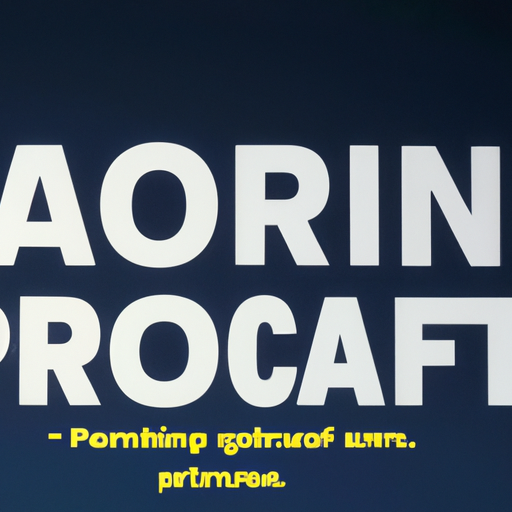
-
Table of Contents
Typography in Focus: Crafting Stunning Text Graphics

Typography is an essential element of design that can greatly impact the effectiveness and aesthetics of text graphics. Whether it’s a logo, website, or social media post, the right typography can make a significant difference in capturing attention, conveying a message, and creating a memorable visual experience. In this article, we will explore the importance of typography in text graphics and provide valuable insights on how to craft stunning designs.
The Power of Typography
Typography goes beyond simply choosing a font. It involves the art and science of arranging type to make written language readable and visually appealing. When it comes to text graphics, typography plays a crucial role in communicating the intended message and evoking the desired emotions. Here are some reasons why typography is so powerful:
- Visual Hierarchy: Typography helps establish a visual hierarchy, guiding the viewer’s eyes through the content and emphasizing key elements. By varying font sizes, weights, and styles, designers can create a clear structure and direct attention to important information.
- Brand Identity: Typography is an integral part of a brand’s identity. Consistent use of fonts across different platforms and materials helps establish brand recognition and reinforces the brand’s personality and values.
- Emotional Impact: Different fonts evoke different emotions. Serif fonts, for example, can convey a sense of tradition and elegance, while sans-serif fonts are often associated with modernity and simplicity. By carefully selecting fonts, designers can enhance the emotional impact of their text graphics.
- Readability: Good typography ensures that text is easy to read and understand. Proper font choice, spacing, and line length contribute to readability, allowing viewers to consume the information effortlessly.
Choosing the Right Fonts
When it comes to typography, choosing the right fonts is crucial. The font selection should align with the purpose, message, and target audience of the text graphic. Here are some tips for selecting fonts:
- Consider the Context: Different fonts are suitable for different contexts. For example, a playful and informal font may work well for a children’s book cover, but it may not be appropriate for a corporate website. Consider the overall tone and purpose of the design when selecting fonts.
- Avoid Font Overload: Using too many fonts in a single design can create visual chaos and distract the viewer. Stick to a maximum of two or three fonts to maintain consistency and coherence.
- Contrast is Key: Pairing fonts with contrasting characteristics can create visual interest and enhance readability. Combining a serif font with a sans-serif font, for example, can create a harmonious balance.
- Test for Legibility: Before finalizing font choices, test them for legibility across different devices and sizes. Fonts that look great on a computer screen may not be as readable on a mobile device.
Typography in Action: Case Studies
Let’s explore some real-world examples of how typography can elevate text graphics:
1. Coca-Cola
Coca-Cola is a brand known for its iconic typography. The company’s logo features a unique script font that has become instantly recognizable worldwide. The flowing curves and distinct letterforms evoke a sense of nostalgia and warmth, aligning with the brand’s values of happiness and togetherness.
2. Apple
Apple is renowned for its minimalist and sleek design aesthetic, and typography plays a significant role in achieving this. The company primarily uses the San Francisco font, a clean and modern typeface that enhances readability across its various products and platforms. The consistent use of typography contributes to Apple’s brand identity and user experience.
3. The New York Times
The New York Times is a prime example of how typography can create a sense of authority and credibility. The newspaper uses a classic serif font, such as Times New Roman, for its print edition. The choice of font reflects the publication’s long-standing reputation and commitment to delivering reliable news.
Typography Tools and Resources
Designers have access to a wide range of tools and resources to aid in the creation of stunning text graphics. Here are some popular ones:
- Adobe Fonts: Formerly known as Typekit, Adobe Fonts offers a vast library of high-quality fonts that can be easily integrated into various design projects.
- Google Fonts: Google Fonts provides a diverse collection of open-source fonts that are free to use. With easy integration and web optimization, it’s a popular choice for web designers.
- Font Pair: Font Pair is a website that suggests font combinations based on visual harmony and contrast. It’s a valuable resource for designers looking for font inspiration.
- Typecast: Typecast is a tool that allows designers to test and experiment with different fonts, sizes, and styles in real-time. It helps streamline the typography selection process.
Summary
Typography is a powerful tool in crafting stunning text graphics. It influences visual hierarchy, brand identity, emotional impact, and readability. By choosing the right fonts, designers can enhance the effectiveness and aesthetics of their designs. Real-world examples, such as Coca-Cola, Apple, and The New York Times, demonstrate the impact of typography on brand recognition and user experience. With the help of various tools and resources, designers can explore and experiment with different fonts to create captivating text graphics. Remember, typography is not just about choosing a font; it’s about creating an immersive visual experience that resonates with the audience.
